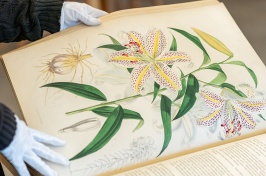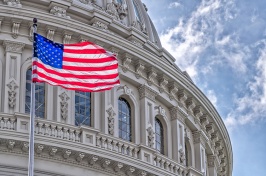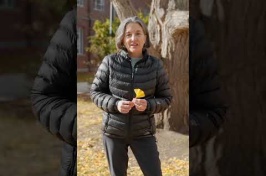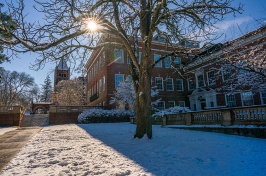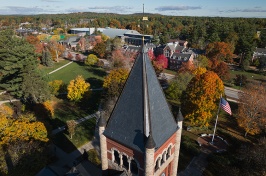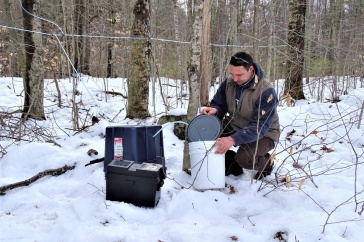
Oriental bittersweet is one of the six invasive woody species found to be of most concern for woodlands in New Hampshire and other Northeast states.
For New Hampshire and nearby states, woodlands are valuable both as direct economic drivers and as outdoor recreational playgrounds. In the Granite State, the forest products industry alone generates an estimated $1.6 billion annually and supports more than 7,000 jobs, with woodlands contributing approximately $2.5 billion in total to the state’s economy. But increasingly, the spread of non-native woody invasive species — such as oriental bittersweet and glossy buckthorn, spurred by changes in climate conditions and land fragmentation — is posing a significant risk to the Northeast’s beloved natural landscapes.
Ranjit Bawa, a researcher at the University of New Hampshire (UNH), is working in partnership with the New Hampshire Agricultural Experiment Station (NHAES) to determine just how big the threat is now and how it may progress in the future. With collaborator Reinmar Seidler (University of Massachusetts, Boston), Bawa collected information to determine the extent of the problem, how it has progressed, and which woody invasive species should receive the most attention. Their research covers all six of the New England states as well as New York, New Jersey and Pennsylvania.

“The goal of the study is to document how such woody invasives are reshaping landscapes in the Northeast,” says Bawa, an assistant professor in the Department of Natural Resources and the Environment at the UNH College of Life Sciences and Agriculture.
Unwanted competition
Because woody invasive species are not native to northern forests, they provide unwanted and sometimes harmful competition for resident plants and trees.
“They are undermining biodiversity, and their proliferation comes at a cost, both in terms of what landowners must spend to control their spread and the ecological value lost when native species are displaced. Yet the regional response remains fragmented, and delaying coordinated action will likely drive even higher costs in the future,” adds Bawa.
The importance of better understanding the current state of woody invasive species in the northeast was a primary driver for the New Hampshire Timberland Owners Association, the NH Department of Agriculture, Markets and Food, and NHAES to support the research and report. The full report of the study is available from the New Hampshire Timberland Owners Association.
The not-so-fabulous five plus one
For the report, the researchers analyzed the U.S. Forest Service’s Forest Inventory & Analysis (FIA) data for 2012 and 2019, in part to filter out plants that were not truly woody invasive species. They also worked with the Society of American Foresters to directly survey professional foresters and land practitioners working in the field. The responses provided data about the most problematic species in a variety of contexts, including private and public lands and forest and agricultural use. Finally, they compiled a database of plants that are prohibited or on the watchlist for all nine states to determine commonalities.
Aided by Steven Roberge, UNH Extension state specialist in forest resources, the researchers used the different data sources to identify the five woody invasive species of highest concern and priority. The five — oriental bittersweet, Japanese barberry, tree of heaven, Norway maple and glossy buckthorn — were introduced accidentally, often spreading from ornamental plantings. Using multiple data sources also highlighted a sixth species, burning bush, which was not included in the FIA data but was consistently flagged by foresters, land practitioners and state agencies, appearing frequently on prohibited or watch lists.
Key findings and recommendations
Comparing the FIA data seven years apart revealed that woody invasive species were expanding at a rate of 0.5% per year during the 2010s. Once data from the 2020s becomes available, researchers will be better positioned to track current growth rates and project future spread. By identifying priority species, the study aims to equip land practitioners with guidance on what to monitor and how to manage invasions. The report also estimates the direct costs of controlling woody invasives, juxtaposed with the indirect ecological costs incurred through ecosystem degradation.

Currently, most people fall back on chemical controls, but those have their own dangers, so figuring out better biological or cultural (preventative) controls, e.g., targeted microbes or livestock grazing in an infested area, is important. The scale of management operations also matters. While larger, more coordinated mitigation projects may be more difficult to implement up front, the report stresses their significant cost advantages over time.
While woody invasive species are present in all nine states studied, the areas of highest infestation are currently to our south, particularly in Pennsylvania. As temperatures rise, proliferation is predicted to accelerate in the north.
“It was crucial to identify the species that deserve priority attention and address where current efforts to mitigate them fall short,” says Bawa. “By accomplishing that, the study can serve as a foundation for smarter, more effective strategies to manage woody invasive species going forward.”
-
Written By:
Mark Wanner | College of Life Sciences and Agriculture | Mark.Wanner@unh.edu





